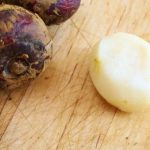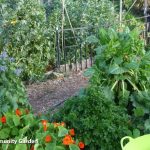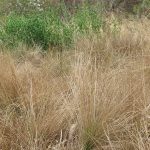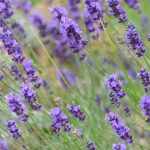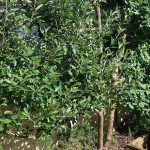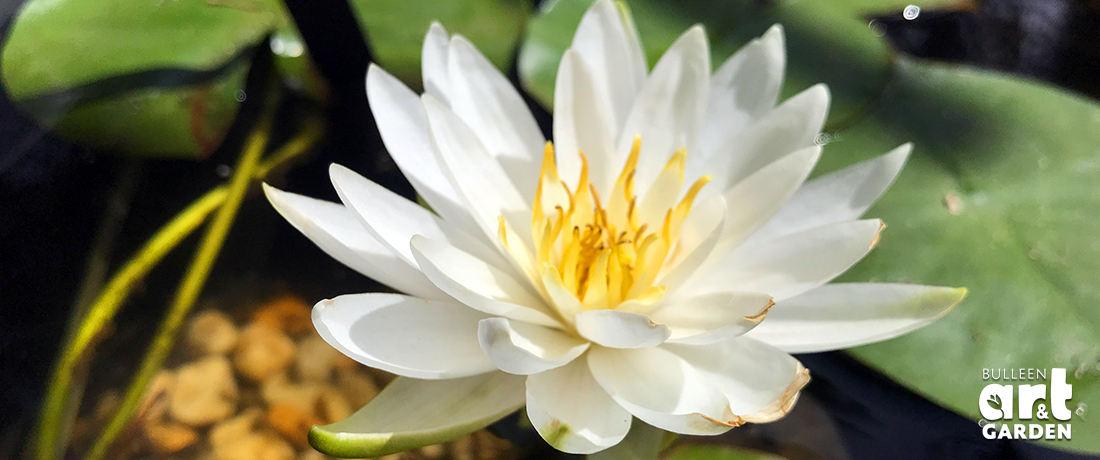
 Important note about plant availability. Important note about plant availability.There are hundreds of factsheets on our website provided for your information. Not all plants will be available at all times throughout the year. To confirm availability please call (03) 8850 3030 and ask for the nursery. |
Water gardens have become a very popular addition to many gardens. There are a wide range of designs and styles to suit any taste or budget. Water gardens can range from very small (a pot or half wine barrel) to large interconnected ponds. To create any water garden there are three main elements you should consider introducing. These are water plants, surrounding vegetation and aquatic animals such as fish, water snails and frogs.
To maintain a healthy aquatic environment, a mixture of plant life and animals such as fish are beneficial. Fish will eat mosquito larvae, reducing the number of mosquitos around the pond. Using a mix of plants in the pond will help to reduce algae growth in the pond and provide a healthy environment for the fish. Plants surrounding the pond provide shade and attract insects as food for the fish, and also provide shelter for frogs. It is prohibited to transport frogs from one area to another, so if you want frogs in your pond, you need to provide a suitable environment to attract local populations. Click here if you would like to read more about attracting frogs to your garden.
It is important to include a mix of different types of aquatic plants to maintain a healthy environment for fish and to reduce algal growth. The water plant equation works out how many plants you need:
For one square metre of pond surface area you need one water lily, three oxygenating plants and one or two marginal plants.
Water Lilies
These plants provide flowers over a long period through the warmer months. Their spreading leaves help to keep the pond water clear by cutting off the sunlight and shading the water beneath. Algae require sun to grow and this is the main cause of murky water. The large leaves also provide excellent shelter for fish. Removing old flowers and leaves every two weeks is advisable. Water Lilies grow best in deeper water, at least 50cm above the pot, so place in the deepest part of the pond.
Repotting water lilies
MATERIALS:
1. WATER PLANT BASKETS/POTS
Plant Baskets prevent pond plants from becoming invasive,whilst at the same time keeping the soil around the plant roots and allowing water flow in order to supply nutrients and oxygen.
This aeration of the soil prevents it from becoming anaerobic (depleted of oxygen) and foul smelling. Planters are great for use with all marginal water plants, submerged plants and water lilies. Choose sizes accordingly.
2. GARDEN BLEND SOIL
(available from landscape supplies in bulk or bags)
3. FINE WHITE SAND
(available from landscape supplies in bulk or bags)
4. PEBBLES
(having a mixture of smaller and larger pebbles works best, the larger ones especially stop fish digging up your lilies at the root. Also available from landscape supplies in bulk or bags)
-AGRIFORM FERTILISER TABLETS
(available in the shop, near the pond pumps)
STEP 1: If you are repotting old pot bound plants, pull them out of their pots and cut them into smaller pieces making sure you have some root ball attached to each of them. The foliage of these will also need to be pruned, much as you would other plants. The cuttings will break down beautifully in the compost. Water Lilies are much the same, but try not to divide into too much as it’s possible to damage the corms. Re-potting lilies should be done every 2 or 3 years in winter when the plants are dormant. Not dividing them will prevent flowering.
STEP 2: Half fill the pot with soil and pack down hard, place the plant in and one fertiliser tablet, two for larger plants like water lilies. Then top up with soil allowing a few centimetres for the remaining materials and press this down firmly to prevent any air pockets.
STEP 3: Place approx. 2cm of the fine white sand on the soil, pack down and then add a layer of the mixed pebbles, placing heavier ones closer to the main stems. Water in and you’re ready to re-position your plants and watch them take off again!
Other Surfacing Plants
These are small plants with floating leaves and flowers, which can be planted between Water Lilies or in any vacant spot in the pond. They should be planted in small pots containing a ratio of 10% aged cow manure to 90% heavy loam or Garden Soil (BAAG Premium Soil Mix is suitable). Planting depth (height of water above soil) should be between 15cm and 20cm.
 Important note about plant availability. Important note about plant availability.There are hundreds of factsheets on our website provided for your information. Not all plants will be available at all times throughout the year. To confirm availability please call (03) 8850 3030 and ask for the nursery. |
- Nardoo – Marsilea quadrifolia is an Australian native with leaves that resemble a four leaf clover.
- Water Poppy – Hydrocleys nymphoides has yellow poppy like flowers and bright green leaves through late spring and summer. Best in full sun.
- Water Hawthorn – Aponogetum distachyos has white, scented flowers with black centres in late winter and spring; bright green floating leaves; tolerates shade.
Submerged Oxygenating Plants
The main benefit of these in a pond is not that they release oxygen into the water but that they grow rapidly and absorb dissolved mineral salts directly through their leaves. They thus compete directly with algae for food. With Water Lilies to cut out the light and oxygenating plants to use up the nutrients, the algae dies and the pond water stays clear. They are a must in a pond.
- Vallisneria spiralis (Eel Grass)
- Myriophyllum spicatum
- Elodea
- Bacopa
Floating Plants
Floating plants provide shade and shelter for fish in outdoor ponds. They feed through their roots, which are suspended in the water. By shading the water and using the nutrients in it they help to suppress algae.
Deep Water Plants
Deep water plants are grown in submerged containers, in a water depth (ideally) of 80cm, though good results may be achieved with a depth as little as 50 to 60cm. Listed below are varieties which will be hardy in our cool temperate climate, and ornamental in a pond of moderate dimensions.
- Water lilies – hardy types
- Vallarsia nymphoides – Water Fringe has small, floating leaves and yellow flowers.
Planting directly into a Pond
You are able to plant aquatic plants directly into larger ponds and dams although it is generally not recommended as it can make maintenance more challenging. Start with a heavy soil without compost or manure with 1″ of course sand or propagating sand on top of the soil. Don’t use brickie sand. To fertilise poke 2/3 agriform tablets in with each plant. Let plants establish for two to three weeks before adding fish. Its also important for the water to be as neutral as possible, between 6 and 8. It is also a good idea to dose up the pond with bacteria as the soil will be full of nutrients.
 Important note about plant availability. Important note about plant availability.There are hundreds of factsheets on our website provided for your information. Not all plants will be available at all times throughout the year. To confirm availability please call (03) 8850 3030 and ask for the nursery. |
Marginal Plants
Pond plants that stand in shallow water with the pot just covered and lift their stems and flowers above it are referred to as marginal plants. They are best contained to individual pots. Use the same potting mix as for other surfacing plants. Some varieties may be planted out of the water in damp positions and are marked *
- * Goat’s Beard – Astilbie varieties are available in a variety of colours from palest pink to red; the flower heads appear from late spring until late summer; best in semi-shade; dies down in winter.
- Lizard’s Tail – Saururus cernuus has heart shaped leaves and creamy white flowers during summer; best in sun.
- * Lobelia cardinalis has lush green foliage and brilliant scarlet flower spikes in late summer; grows to 90cm.
- Marsh Marigold – Caltha palustris has golden yellow flowers from early winter to spring held above the kidney shaped leaves. Full sun.
- Papyrus – Cyperus papyrus. The Egyptian Paper Plant. A tall variety which grows to 2m. Plant in full sun.
- Umbrella Grass – Cyperus alternifolius has bright green umbrella-like foliage on 50cm stems; best in full sun.
- Cyperus longus – graceful arching foliage 120cm
- Pickerel Rush – Pontederia cordata has heart shaped leaves and heads of bright blue flowers in summer; grows to 75cm best in sun.
- * Sedge – Carex morrowii ‘Bressingham’ slow beautiful growth. Does best with a bit of sun and features attractive, variegated foliage.
- * The Sweet Flag – Acorus gramineus variegatus features attractive, striped green and creamy white leaves to 20cm and can be grown in shade.
- Acorus calamus variegatus – features striped green / white leaves and grows to around 50cm tall.
Bog Plants
There are many plants suitable for growing in damp positions by ponds. Those marginal plants marked with a * fall into this category as well as the plants listed below.
- Bugle flower – Ajuga. There are several varieties with different coloured leaves and blue flower spikes; best grown in semi-shade.
- Blazing Star – Liatris spicata has deep purple spikes in summer and grows best in full sun. Dies down in winter.
- Creeping Jenny – Lysimachia nummularia is a ground cover best grown in semi-shaded positions.
- Ferns – there are many types of ferns that enjoy damp shady areas; Maidenhairs (Adiantum), Bird’s Nest, Hen and Chicken Ferns (Asplenium) and some Pteris varieties are particularly suitable.
- Plantain Lily – (Hosta varieties) There are many different varieties available, some with variegated foliage. They feature lavender flower spikes in summer and grow best with some morning sun. Dies down in winter.
- Scaveola have blue flowers through spring and summer. They are Australian natives and grow best in half sun.
Plants for the pond surround
These should be in harmony with the pond and accentuate it. This may be a matter of personal taste, however, there are some plants that particularly suit this purpose. Some of them are listed below.
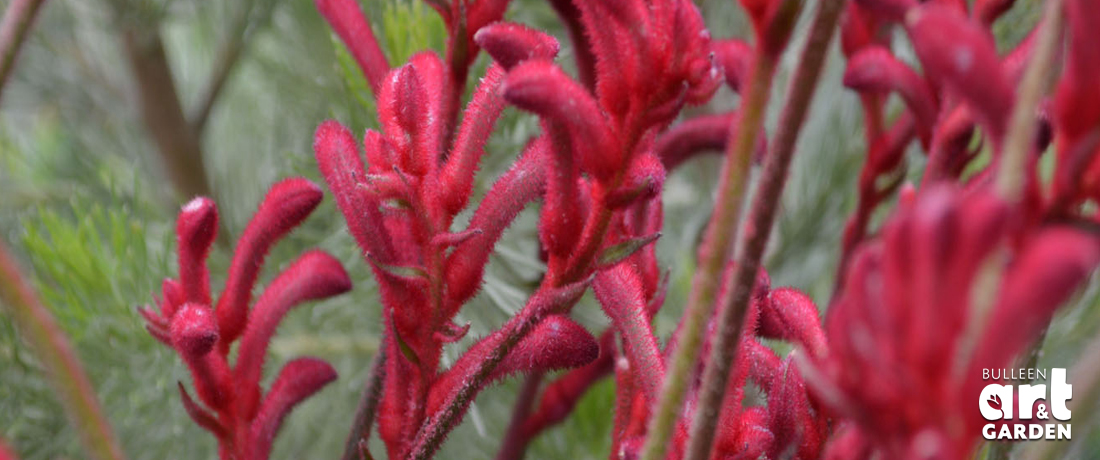
- Blue Grass – Festuca glauca
- Calla Lilies – Zantedeschia childsiana. Green Goddess or one of the coloured varieties. The common Arum Lily is a weed.
- Cannas – dwarf flowering varieties.
- Dissectum Maples – Acer palmatum ‘Dissectum’.
- Kangaroo Paws – Anigozanthus (several varieties)
- Variegated Ribbon Grass – Holcus bulbosa ‘Variegata’.
 Important note about plant availability. Important note about plant availability.There are hundreds of factsheets on our website provided for your information. Not all plants will be available at all times throughout the year. To confirm availability please call (03) 8850 3030 and ask for the nursery. |

